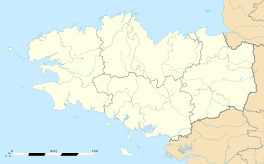Plogoff
|
Plogoff Plougoñ |
||
|---|---|---|

A storm at Pors Loubous
|
||
|
||
| Coordinates: 48°02′15″N 4°39′53″W / 48.0375°N 4.6647°WCoordinates: 48°02′15″N 4°39′53″W / 48.0375°N 4.6647°W | ||
| Country | France | |
| Region | Brittany | |
| Department | Finistère | |
| Arrondissement | Quimper | |
| Canton | Pont-Croix | |
| Intercommunality | Cap-Sizun | |
| Government | ||
| • Mayor (2014–2020) | Maurice Lemaître | |
| Area1 | 11.73 km2 (4.53 sq mi) | |
| Population (2013)2 | 1,291 | |
| • Density | 110/km2 (290/sq mi) | |
| Time zone | CET (UTC+1) | |
| • Summer (DST) | CEST (UTC+2) | |
| INSEE/Postal code | 29168 /29770 | |
| Elevation | 0–80 m (0–262 ft) | |
|
1 French Land Register data, which excludes lakes, ponds, glaciers > 1 km² (0.386 sq mi or 247 acres) and river estuaries. 2Population without double counting: residents of multiple communes (e.g., students and military personnel) only counted once. |
||
1 French Land Register data, which excludes lakes, ponds, glaciers > 1 km² (0.386 sq mi or 247 acres) and river estuaries.
Plogoff (in Breton Plougoñ) is a commune in the Finistère department of Brittany in north-western France.
It contains three small ports suitable for small vessels: Pors-Loubous, Feunten-Aod and Bestrée. Local industries include tourism, traditional biscuits, agriculture and fishing.
Inhabitants of Plogoff are called in French Plogoffistes.
As for other cities like Guiscriff, Plélauff or the surnames Le Hénaff, Heussaff or Gourcuff, the digraph -ff was introduced by Middle Ages' authors to indicate a nasalizetion vowel.
In the early 1970s, the French state power company, EDF, decided to establish a nuclear power plant in Brittany. The first proposed site was in Erdeven, Morbihan, but objections arose. EDF then proposed Ploumoguer, Finistère, just north of Brest. Councilmen around Brest redirected their attention to Plogoff. Local residents then blocked access to the site in 1976, while protests resumed in 1978 and 1979.
In 1980, the national government and EDF attempted to fulfil their statutory obligations to display the required inquiry documents in the local mairie or city hall. Local officials burned the documents and refused to allow replacements to be displayed. In response, the national government set up mobile mairies annexes to display the documents in town centres. These mairies annexes became the focus of the protest movement.
...
Wikipedia



